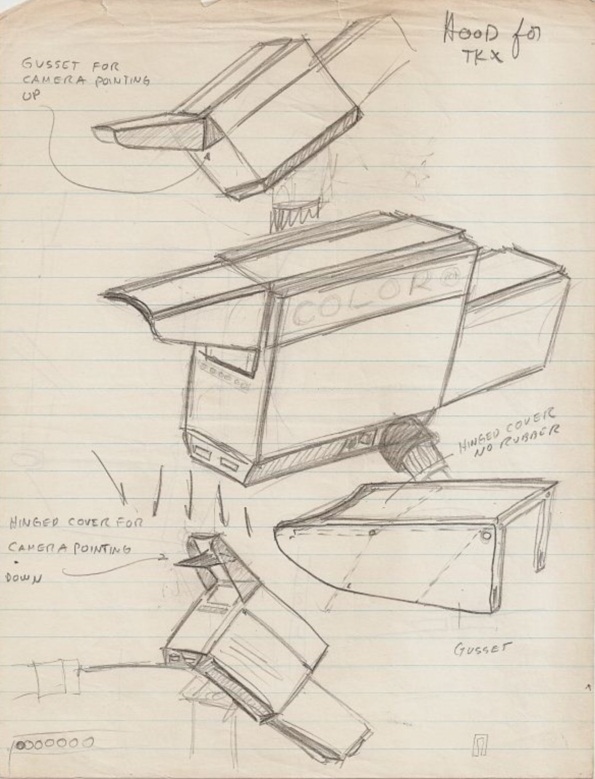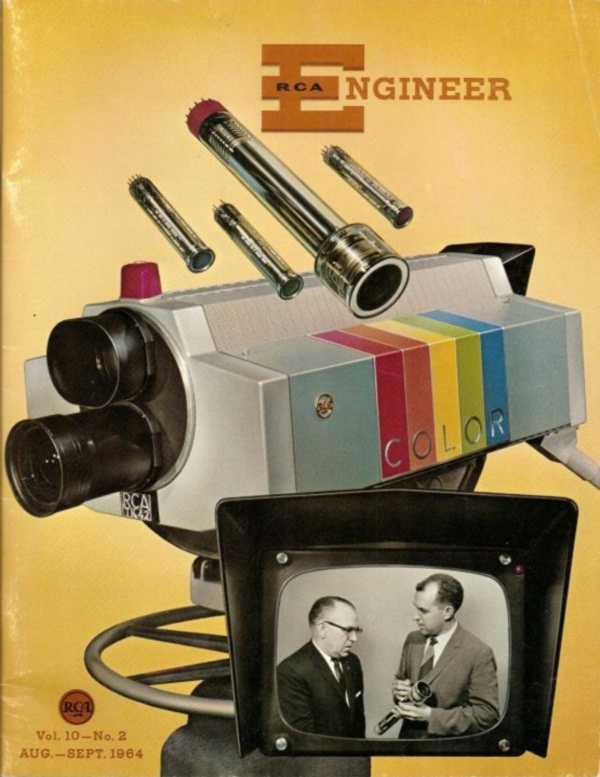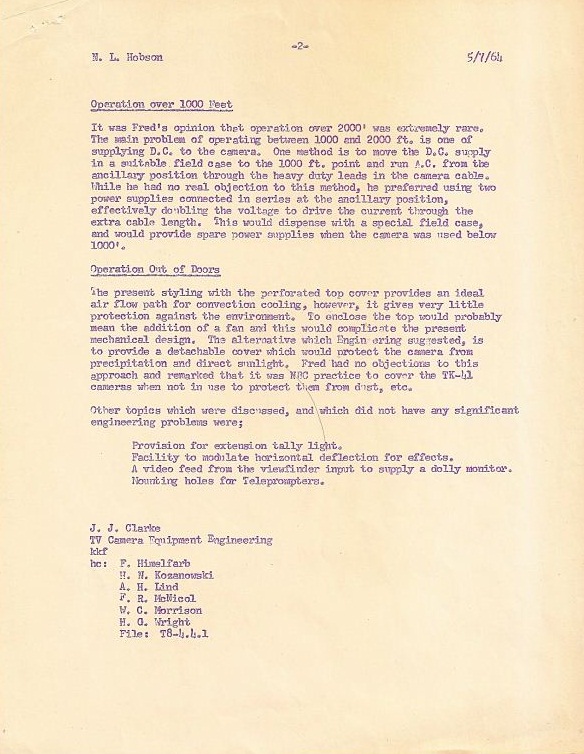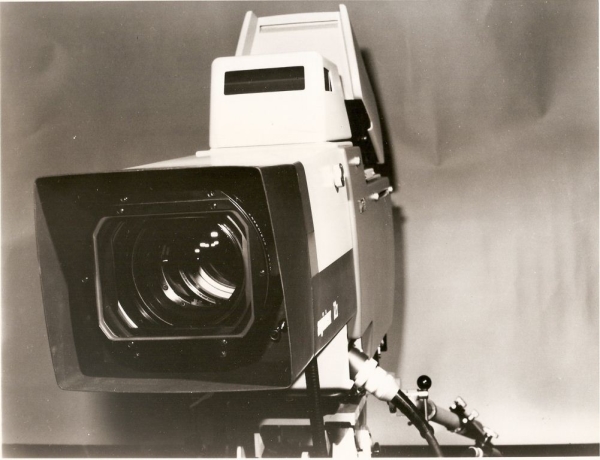

The Virtual Archives of RCA Engineer Harry Wright
He helped design the RCA TK42, TK42XX, TK43, TK44, TK47, TK48, TK76 and more.

The man in the suit is Harry Wright, one of RCA’s most respected mechanical engineers.
I had the privilege of getting to know the man who designed some famous cameras for RCA, Mr. Harry Wright. To get things started with a big bang, here are the first ever, hand drawn images of two of those cameras.

This is Harry’s first rough sketch of how the RCA TK42 should look.

Here is Harry’s first sketch of the TK44.

Here are some of Harry’s ideas on a new viewfinder hood for the TK44.

This simple schematic from June 1967 lays out Harry’s first thoughts on the internal construction of the TK44.
WOW! Great stuff, isn’t it? I have about a dozen more of the first detailed schematics of the TK42, 42XX, 43, 44 and 45 cameras that I would love to show you, but they are huge, blueprint size 20 x 30 inch sheets and too big to display here.
If you are curious about the TK42XX as mentioned above and wonder what in the world that is, well, take a look…perhaps your first ever at the dual-lens TK42 experimental camera below.



Above, you see the finished product…the RCA TK42XX dual-lens camera, and although it never was put in production, it was built. To build one, you have to have plans, and below is one of Harry’s early schematics of the TK42XX from October 1963.

Before we go further, I want to comment on the first image on this page…the one of Harry looking at a red plastic tape. In that photo, he is double checking the information on the dot coded ‘instruction’ tape for the new, automated three-axis lathe at RCA. The project he is working on is the front face panel of the TK44 plumbicon camera. Just below is the three-axis lathe and below that, the finished product, the TK44 face plate.


Below is the first mock-up of the TK44 from RCA’s art department. Harry’s copy shows that he knew some top vents would be necessary, so he drew them in on his copy; later, Harry came up with the hinged top door with horizontal vents.

Among the papers and photos Harry sent are some delicious, never before seen images from the RCA engineering lab in Camden where each camera’s first editions were built. Below are photos of TK42 and TK43 cameras in that lab, in various stages of their initial mock-up construction and completion.

Looking closely above, you can see the Varatol 3 internal lens sticking out of the camera body though the lens hole as the first TK42 is constructed. This was the TK42s Achilles heel of sorts. With the lens now inside, the heat of the electronics affected the internal mechanics of the lens and made the zoom process unreliable at times when the lens elements expanded and ‘chattered’ instead of gliding smoothly. Note that the images had to come all the way to the back of the camera before being split up and sent to the optics side of the camera (right side) as seen below.


Here is a close up of the Varatol 3 lens used in the TK42 and 43.

Above is the art department’s final version of the TK42 and below is the engineering lab’s final version as it sits finally mounted, ready for testing. Below that is a close up of the mock-up camera from the operator’s position.




Above, two images of the completed TK43 in the Camden RCA lab and below, two close ups of the front of the 43 without the Varotal 3 external lens.


Now to something that, to me, is quite interesting. Unknown to most is the name Fred Himelfarb, but his name is something you cannot avoid in the historical discussion of color television at NBC and RCA, and even Norelco. As you can read on the TK41 Camera page top, Fred was a driving force in the development of how color cameras were built and operated. Fred came from RCA to NBC with the first TK40s and was the official ‘man in the middle’ between NBC and RCA on all their cameras. Below is a memo that Harry was included on, and it’s all about what Fred thought of the RCA TK42 after a visit to Camden on May 5, 1964.


Item one in the memo is the D handles on the TK42. These were designed by Harry Wright, and if you read the TK42 page on this site, you will see that there were very mixed emotions about this new ergonomic addition. Harry was actually kind of in the dog house for a while, but not for long. Item three deals with camera cables and the expense of changing them and accessing them at NBC’s 30 Rock headquarters. What is interesting about this is Fred is the one that came up with the single cable fix on the TK40-41s that eliminated the bulky and excessive three-cable setup that each camera required early on.
Finally, although Fred did not condemn the TK42, he did not praise it either. Matter of fact, NBC never bought a single TK42 or 43, HOWEVER, below are the only known pictures of one of two TK43s RCA “loaned” to NBC NY and never came back to pick them up.

This is one of two TK43s that were delivered to NBC in New York by RCA as loaners. Fred told me they came in the day before a big election so the plan was to put them to work on the election set. Try as they may, they could not get them the pictures right before air time, so they put the logos on them and used them as prop cameras with cameramen behind them on the set just to make it look good. They eventually wound up in a small ‘always hot’ news studio with the cameras on 24 hours a day just in case there had to be a live news bulletin from an NBC news reporter. I think that studio was also used by WNBC for a 1:30 AM newsbreak. The unusual looking lens is believed to be an experimental Varotal Mark XIV with possible a 16 to 1 ratio. No one knows what ever happened to them.


Well, well, well. What have we here? Above and below are the only two known images of what are believed to be an early prototype of the TK47 camera. I like this a lot better than the final version of the TK47.

Although I wish my friend Chuck Pharis luck in finding one of only two TK48s ever made, here is something almost as rare: an RCA promotion piece on the elusive, never-manufactured TK48 Studio Camera. Below is the full document with all the features and details, and below that is a close up of the image.



Above is an ad for the TK44 and below an ad for the TK47…oddly, the only RCA studio camera to ever win an Emmy Award.

In closing, I need to mention that early on at RCA, Harry was quite involved in telecine camera creations and worked on many projects during his many years there. He started as a young pup and worked for RCA his entire carrier and left with a bang! One of Harry’s last projects was a camera that changed everything when it debuted in 1976. It was the RCA TK76 ENG camera (thus the 76 in the name), and if you look at the RCA ad below and think of how Harry’s designs always demanded that RCA cameras be rugged, you can understand how this camera survived a fall from an airplane and continued to work. There is much more to the Harry Wright story, but I feel fortunate and privileged to be able to tell part of it and to know him. Thanks, Harry, and God Bless You!

Since Harry has such a good sense of humor, I want to leave you with one last thing. Below is an official RCA memo of ‘thanks’ to the people involved with the TK47 project and the less than lavish memento given to them in appreciation for all their hard work on this Emmy Award winning camera. It’s kind of funny and kind of sad, but, such is life!

[…] https://eyesofageneration.com/39409/ […]
[…] https://eyesofageneration.com/39409/ […]